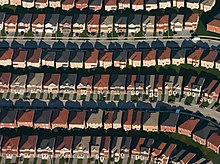Row settlement

A row settlement is a planned urban development that - unlike row house settlements - consists of separate or free-standing houses. Modern row settlements are found mainly in North America, often in the form of tract housing . A construction company erects the houses in a planned area in series production and, thanks to the more efficient production, achieves lower prices compared to individually planned houses. In Europe, row settlements are mainly to be found in the Netherlands, where rows of similar houses were built, especially in drained areas (land reclamation). Row settlements are often built on the outskirts, z. B. Collieries .
In the USA, Levittown (New York) is regarded as the model of Tract Housing, as the American form of (sub) urban life. In the first decades of Tract Housing, very uniform settlements were built, sometimes with just one type of building. Modern tract housing areas show a much greater variability in their external shape, for example through the use of different garages or terraces on the basis of an identical building core. The standardization of the components can save considerable costs; construction workers can be trained in a few simple steps. The infrastructure during construction is created only once for a large number of buildings and in many cases complex parts such as stairs, roofs and wet rooms are preassembled and delivered in factories. The widespread row settlements have led to nicknames like McHousing in the USA , based on McDonald’s fast-food restaurants.

